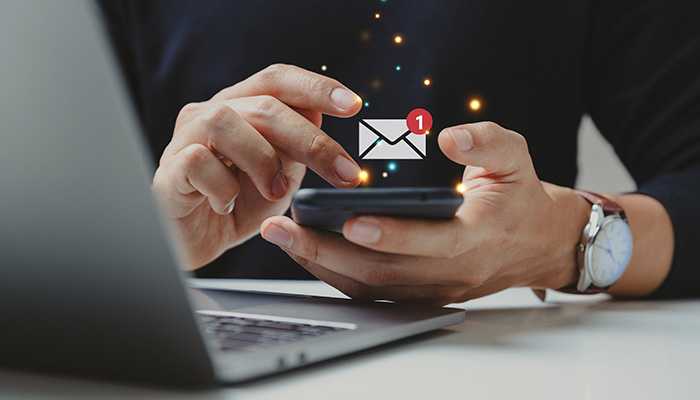Mastering the Art of Email Signatures: A Comprehensive Guide
Mastering the Art of Email Signatures: A Comprehensive Guide
Oct 10, 2023 04:12 PM
Mastering the Art of Email Signatures: A Comprehensive Guide
Oct 10, 2023 04:12 PM

In today's digital age, email has become integral to our personal and professional communication. Whether it's for business correspondence, networking, or personal interactions, email is the go-to platform for many. However, emails go beyond the content of the message. The email signature, often overlooked, plays a vital role in making a lasting impression and conveying essential information about you or your organization. In this comprehensive guide, we will explore the art of mastering email signatures.
Email signatures are more than just the block of text that appears at the end of your email. They are a representation of your identity, both as an individual and as a professional. Here's why email signatures matter:
A well-crafted email signature exudes professionalism. It shows that you pay attention to detail and take your online presence seriously. In a business context, professionalism can make or break a deal, partnership, or job opportunity.
For businesses, email signatures are a valuable branding tool. Consistent, well-designed signatures can reinforce your brand's identity and create a sense of trust and recognition among recipients.
Email signatures are a convenient way to share your contact information. This includes your name, title, company, phone number, and physical address. This makes it easy for recipients to get in touch with you or your organization.
Email signatures can be used to promote events, webinars, product launches, and more. They serve as a mini advertising space to engage your audience.
To master the art of email signatures, it's essential to understand the key elements that go into creating an effective one. Here are the core components of a well-crafted email signature:
Your name and professional title should be prominently featured. It's often the first piece of information recipients look for to identify you and your role.
For businesses, the company logo is a crucial branding element. It should be included in your email signature to reinforce your brand identity.
Include your phone number, email address, and physical address. This makes it easy for recipients to reach out through various channels.
Link to your professional social media profiles, such as LinkedIn, Twitter, or Facebook. This encourages recipients to connect with you on other platforms.
If applicable, include a link to your website. This is especially important for businesses, as it drives traffic to your online presence.
Adding a professional headshot to your email signature personalizes your emails and helps recipients put a face to the name.
In certain industries, legal disclaimers are required for compliance. Make sure your email signature adheres to the regulations of your industry.

The design of your email signature is crucial. It should be visually appealing, easy to read, and consistent with your brand. Here are some design principles to consider:
Keep your email signature simple and uncluttered. Avoid excessive graphics or too much text. A clean and minimalistic design is more effective.
Your email signature should be consistent with your brand's colors, fonts, and style. This reinforces your brand identity.
With the increasing use of mobile devices, ensure that your email signature looks good and functions well on smartphones and tablets.
Use legible fonts and font sizes. Your email signature should be easy to read at a glance.
Maintain a balanced layout. Elements should be well-spaced and not crowded together.
If you include images, ensure they are properly formatted, not too large, and relevant to your brand or message.
To master the art of email signatures, it's important to know what to do and what to avoid. Here are some dos and don'ts:
Do Keep It Updated: Regularly update your email signature to reflect any changes in your contact information or role.
Do Use a Professional Email Address: Make sure your email address is professional and associated with your domain or organization.
Do Include a Call to Action: Encourage recipients to take action, whether it's visiting your website, connecting on LinkedIn, or signing up for a newsletter.
Do Test on Multiple Email Clients: Ensure that your email signature displays correctly on various email clients and devices.
Don't Overcomplicate: Avoid cluttering your email signature with too much information or design elements.
Don't Use Non-Standard Fonts: Stick to standard, web-safe fonts to ensure your signature displays consistently for all recipients.
Don't Go Overboard with Images: Using too many images can slow down the loading of your emails and appear unprofessional.
Don't Include Personal Information: Your email signature is not the place for personal information like your home address.
Creating a well-designed email signature is easier with the help of various tools and software. Here are some popular options:
There are online tools that allow you to create email signatures by simply filling out a form. These tools generate the HTML code for your signature, which you can then copy and paste into your email client.
Many email clients and marketing automation platforms offer email signature templates that you can customize with your information and branding.
For a highly customized email signature, you can use professional design software like Adobe Photoshop or Illustrator to create a signature from scratch.
For businesses, email signature management software provides a centralized way to create and deploy consistent signatures across the organization.
Each email client (e.g., Gmail, Outlook, Apple Mail) has its own method for creating and editing email signatures. Here's a general guide on how to implement your email signature in popular email clients:
In Gmail, go to Settings (the gear icon in the upper right).
Scroll down to the "Signature" section.
Create or edit your signature using the built-in editor.
Remember to click "Save Changes."
In Outlook, click "File" and then "Options."
Select "Mail" and then "Signatures."
Create a new signature and customize it to your liking.
Save your changes.
In Apple Mail, go to "Mail" and select "Preferences."
Click on the "Signatures" tab.
Create or edit a signature for your account.
Choose the default signature for new messages.
For webmail clients like Yahoo or AOL, access the settings or options menu to locate the signature section. The process is similar to Gmail or Outlook.
To gain a deeper understanding of effective email signatures, let's explore some real-world case studies and examples:
Name: John Doe
Title: Marketing Manager
Company: Doe Marketing Agency
Phone: 123-456-7890
Email: john.doe@example.com
LinkedIn: linkedin.com/in/johndoe
Website: www.doemarketingagency.com
Image: Professional headshot
[Company Logo]
Name: Jane Smith
Title: Sales Director
Company: XYZ Corporation
Phone: 987-654-3210
Email: jane.smith@xyzcorp.com
Address: 123 Main St, Cityville, ST 12345
LinkedIn: linkedin.com/in/janesmith
Website: www.xyzcorp.com
Image: Company logo
Name: Alex Turner
Title: Event Manager
Company: Event Solutions Inc.
Phone: 555-123-4567
Email: alex.turner@eventsolutions.com
Website: www.eventsolutions.com
Image: Upcoming event banner with "Register Now" CTA
Managing email signatures, especially in a business context, can be a challenge. Here are some best practices for email signature management:
For businesses, consider using email signature management software that allows you to centrally control and update signatures for all employees.
Maintain a consistent email signature format and design across the organization to reinforce brand identity.
Ensure that email signatures are regularly updated to reflect any changes in contact information or branding.
Provide employees with guidelines on how to use and format their email signatures, and offer training as needed.
Be aware of industry regulations and legal requirements related to email signatures, such as disclaimers for specific sectors.
Mastering the art of email signatures is a subtle yet impactful skill that can enhance your professionalism, branding, and communication. Whether you're an individual or part of an organization, taking the time to create and manage effective email signatures is a worthwhile endeavor. Your email signature is not just a sign-off; it's an introduction, a statement, and a reminder of who you are and what you represent. So, craft your signature with care and make it a powerful tool in your digital toolkit.